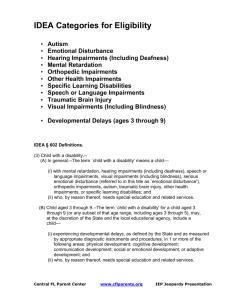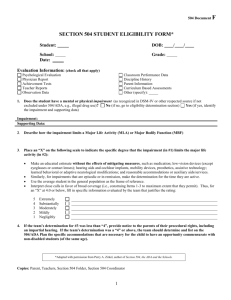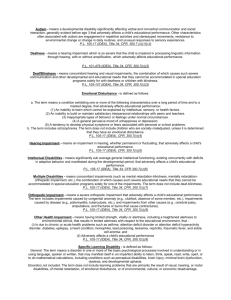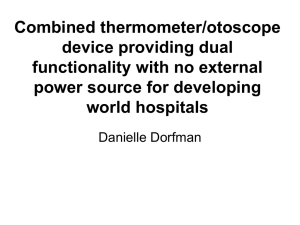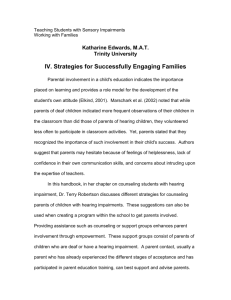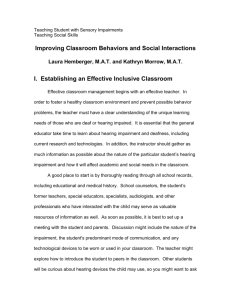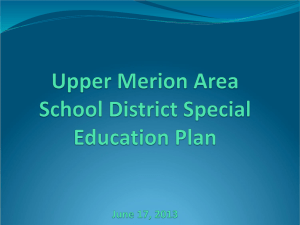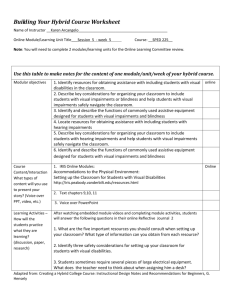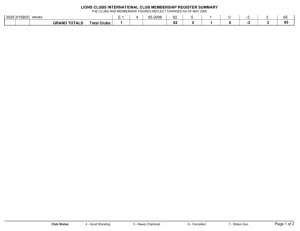Special Education Eligibility Criteria
advertisement
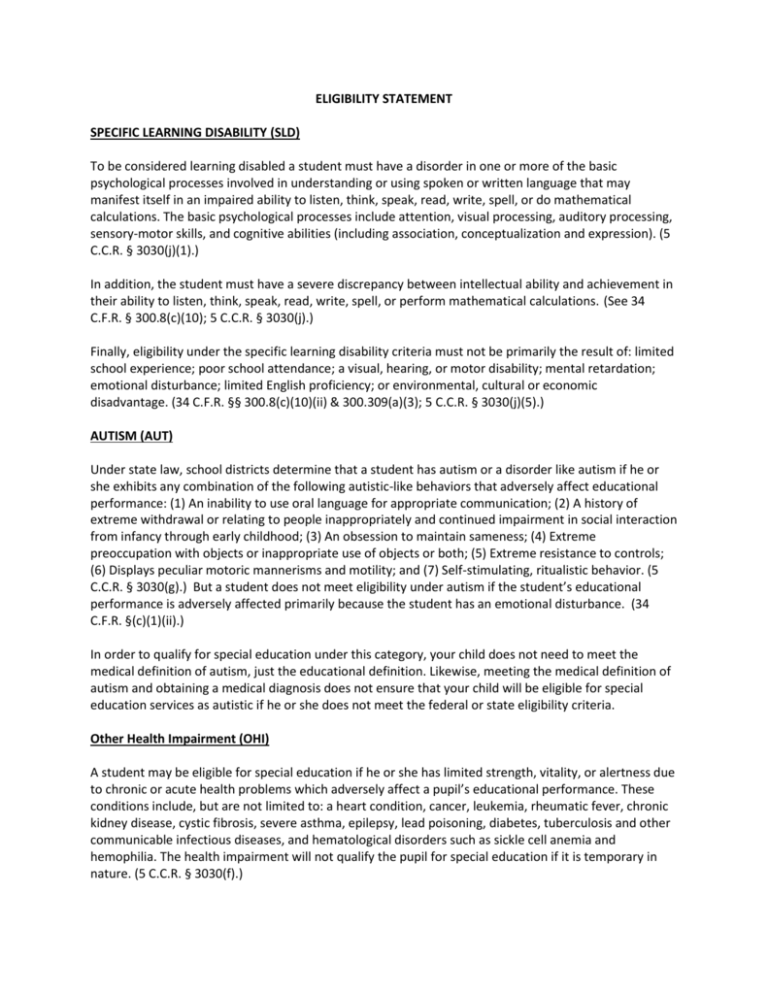
ELIGIBILITY STATEMENT SPECIFIC LEARNING DISABILITY (SLD) To be considered learning disabled a student must have a disorder in one or more of the basic psychological processes involved in understanding or using spoken or written language that may manifest itself in an impaired ability to listen, think, speak, read, write, spell, or do mathematical calculations. The basic psychological processes include attention, visual processing, auditory processing, sensory-motor skills, and cognitive abilities (including association, conceptualization and expression). (5 C.C.R. § 3030(j)(1).) In addition, the student must have a severe discrepancy between intellectual ability and achievement in their ability to listen, think, speak, read, write, spell, or perform mathematical calculations. (See 34 C.F.R. § 300.8(c)(10); 5 C.C.R. § 3030(j).) Finally, eligibility under the specific learning disability criteria must not be primarily the result of: limited school experience; poor school attendance; a visual, hearing, or motor disability; mental retardation; emotional disturbance; limited English proficiency; or environmental, cultural or economic disadvantage. (34 C.F.R. §§ 300.8(c)(10)(ii) & 300.309(a)(3); 5 C.C.R. § 3030(j)(5).) AUTISM (AUT) Under state law, school districts determine that a student has autism or a disorder like autism if he or she exhibits any combination of the following autistic-like behaviors that adversely affect educational performance: (1) An inability to use oral language for appropriate communication; (2) A history of extreme withdrawal or relating to people inappropriately and continued impairment in social interaction from infancy through early childhood; (3) An obsession to maintain sameness; (4) Extreme preoccupation with objects or inappropriate use of objects or both; (5) Extreme resistance to controls; (6) Displays peculiar motoric mannerisms and motility; and (7) Self-stimulating, ritualistic behavior. (5 C.C.R. § 3030(g).) But a student does not meet eligibility under autism if the student’s educational performance is adversely affected primarily because the student has an emotional disturbance. (34 C.F.R. §(c)(1)(ii).) In order to qualify for special education under this category, your child does not need to meet the medical definition of autism, just the educational definition. Likewise, meeting the medical definition of autism and obtaining a medical diagnosis does not ensure that your child will be eligible for special education services as autistic if he or she does not meet the federal or state eligibility criteria. Other Health Impairment (OHI) A student may be eligible for special education if he or she has limited strength, vitality, or alertness due to chronic or acute health problems which adversely affect a pupil’s educational performance. These conditions include, but are not limited to: a heart condition, cancer, leukemia, rheumatic fever, chronic kidney disease, cystic fibrosis, severe asthma, epilepsy, lead poisoning, diabetes, tuberculosis and other communicable infectious diseases, and hematological disorders such as sickle cell anemia and hemophilia. The health impairment will not qualify the pupil for special education if it is temporary in nature. (5 C.C.R. § 3030(f).) The definition for OHI includes attention deficit disorder (“ADD”) or attention deficit hyperactivity disorder (“ADHD”) as an example of a chronic illness which could qualify. However, a medical diagnosis of ADD or ADHD alone is not sufficient to make a student eligible for special education services. INTELLECTUALLY DISABLED (ID) In order for a student to be considered intellectually disabled, a child must show: (1) deficits in adaptive behavior; and (2) significantly below average general intellectual functioning. Both must have manifested during the developmental period and adversely affect her current educational performance. (34 C.F.R. § 300.8(c)(6); 5 C.C.R. § 3030(h).) EMOTIONALLY DISTURBED (ED) A student is considered seriously emotionally disturbed if, because of a serious emotional disturbance, the child exhibits one or more of the following characteristics, over a long period of time and to a marked degree, which adversely affects educational performance: (1) An inability to learn which cannot be explained by intellectual, sensory, or health factors; (2) An inability to build or maintain satisfactory interpersonal relationships with peers and teachers; (3) Inappropriate types of behavior or feelings under normal circumstances exhibited in several situations; (4) A general pervasive mood of unhappiness or depression; and (5) A tendency to develop physical symptoms or fears associated with personal or school problems. (34 C.F.R. § 300.8(c)(4); 5 C.C.R. § 3030(i).) TRAUMATIC BRAIN INJURY (TBI) Traumatic brain injury means an acquired injury to the brain caused by an external physical force, resulting in total or partial functional disability or psychosocial impairment, or both, that adversely affects a child's educational performance. Traumatic brain injury applies to open or closed head injuries resulting in impairments in one or more areas, such as cognition; language; memory; attention; reasoning; abstract thinking; judgment; problem-solving; sensory, perceptual, and motor abilities; psychosocial behavior; physical functions; information processing; and speech. Traumatic brain injury does not apply to brain injuries that are congenital or degenerative, or to brain injuries induced by birth trauma. (34 C.F.R. § 300.8(c)(12).) DEAF Deafness means a hearing impairment that is so severe that the child is impaired in processing linguistic information through hearing, with or without amplification that adversely affects a child’s educational performance. (34 C.F.R. § 300.8(c)(2).) HEARING IMPAIRED (HH) A student is eligible if the student has either a permanent or fluctuating hearing loss that impairs his or her ability to process information presented through amplified hearing channels and which also adversely affects educational performance. (34 C.F.R. § 300.8(c)(5); 5 C.C.R. § 3030(a).) DEAF/BLIND (DB) A student is eligible under the category of deaf/blind if the student has both hearing and visual impairments which, in combination, cause such severe communication, developmental, and educational problems that the student cannot be accommodated in a program for children with only hearing impairments or only visual impairments. (34 C.F.R. § 300.8(c)(2); 5 C.C.R. § 3030(b).) VISUALLY IMPAIRED (VI) Visually handicapped means a visual impairment that, even with correction, adversely affects a child’s educational performance. The term includes both partially sighted and blind children. (34 C.F.R. § 300.8(c)(13); 5 C.C.R. § 3030(d).) SEVERE ORTHOPEDIC IMPAIRMENT (OI) A severe orthopedic impairment is one which adversely affects the pupil’s educational performance and including those caused by congenital anomaly, impairments caused by disease (e.g., poliomyelitis, bone tuberculosis, etc.), and impairments from other causes (e.g., cerebral palsy, amputations, and fractures or burns that cause contractures). (5 C.C.R. Sec. 3030(e); 34 C.F.R. § 300.8(c)(8).) MULTIPLE DISABILITIES (MD) Multiple disabilities means concomitant impairments (such as mental retardation-blindness or mental retardation-orthopedic impairment), the combination of which causes such severe educational needs that they cannot be accommodated in special education programs solely for one of the impairments. Multiple disabilities does not include deaf-blindness. (34 C.F.R. § 300.8(c)(7).) Keep in mind that the following is an exception to EVERY eligibility category: In making a determination of eligibility a student must not be determined to be an individual with exceptional needs if the determinant factor for the determination is due to: (1) lack of appropriate instruction in reading; (2) lack of appropriate instruction in mathematics; (3) limited English proficiency; or (4) If the student does not otherwise meet the eligibility criteria under any other eligibility category as defined by federal law. (Ed. Code § 56329(a)(2)(A-D).)
